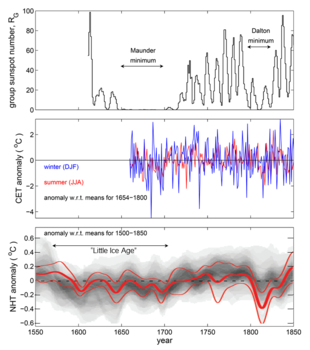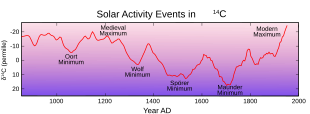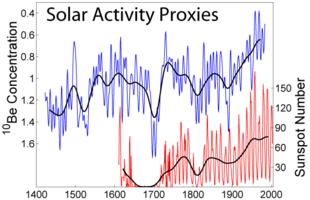The Maunder Minimum shown in a 400-year history of sunspot numbers
The Maunder Minimum, also known as the "prolonged sunspot minimum", is the name used for the period around 1645 to 1715 during which sunspots became exceedingly rare, as was then noted by solar observers.
The term was introduced after John A. Eddy published a landmark 1976 paper in Science. Astronomers before Eddy had also named the period after the solar astronomers Annie Russell Maunder (1868–1947) and her husband, Edward Walter Maunder (1851–1928), who studied how sunspot latitudes changed with time. The period which the Maunders examined included the second half of the 17th century.
Two papers were published in Edward Maunder's name in 1890 and 1894, and he cited earlier papers written by Gustav Spörer.
Because Annie Maunder had not received a university degree,
restrictions at the time caused her contribution not to be publicly
recognized.
Spörer noted that, during a 28-year period (1672–1699) within the
Maunder Minimum, observations revealed fewer than 50 sunspots. This
contrasts with the typical 40,000–50,000 sunspots seen in modern times
(over similar 25 year sampling).
The Maunder Minimum occurred with a much longer period of lower-than-average European temperatures which is likely to have been primarily caused by volcanic activity.
Sunspot observations
The Maunder Minimum occurred between 1645 and 1715 when very few sunspots were observed. That was not because of a lack of observations, as during the 17th century, Giovanni Domenico Cassini carried out a systematic program of solar observations at the Observatoire de Paris, thanks to the astronomers Jean Picard and Philippe de La Hire. Johannes Hevelius also performed observations on his own. Here is the total of sunspots recorded, by example, in the decennial years (omitting Wolf numbers):
| Year | Sunspots |
|---|---|
| 1610 | 9 |
| 1620 | 6 |
| 1630 | 9 |
| 1640 | 0 |
| 1650 | 3 |
| 1660 | Some sunspots (20<) reported by Jan Heweliusz in Machina Coelestis |
| 1670 | 0 |
| 1680 | 1 huge sunspot observed by Giovanni Domenico Cassini |
During the Maunder Minimum enough sunspots were sighted so that 11-year cycles could be extrapolated from the count.
The maxima occurred in 1676–1677, 1684, 1695, 1705 and 1718.
Sunspot activity was then concentrated in the southern hemisphere
of the Sun, except for the last cycle when the sunspots appeared in the
northern hemisphere, too.
According to Spörer's law, at the start of a cycle, spots appear at ever lower latitudes until they average at about latitude 15° at solar maximum.
The average then continues to drift lower to about 7° and after
that, while spots of the old cycle fade, new cycle spots start appearing
again at high latitudes.
The visibility of these spots is also affected by the velocity of the Sun's surface rotation at various latitudes:
| Solar latitude | Rotation period (days) |
|---|---|
| 0° | 24.7 |
| 35° | 26.7 |
| 40° | 28.0 |
| 75° | 33.0 |
Visibility is somewhat affected by observations being done from the ecliptic.
The ecliptic is inclined 7° from the plane of the Sun's equator (latitude 0°).
Little Ice Age
Comparison
of group sunspot numbers (top), Central England Temperature (CET)
observations (middle) and reconstructions and modeling of Northern
Hemisphere Temperatures (NHT). The CET in red are summer averages (for
June, July and August) and in blue winter averages (for December of
previous year, January and February). NHT in grey is the distribution
from basket of paleoclimate reconstructions (darker grey showing higher
probability values) and in red are from model simulations that account
for solar and volcanic variations. By way of comparison, on the same
scales the anomaly for modern data (after 31 December 1999) for summer
CET is +0.65oC, for winter CET is +1.34oC, and for NHT is +1.08oC. Sunspot data are as in supplementary data to and Central England Temperature data are as published by the UK Met Office The NHT data are described in box TS.5, Figure 1 of the IPCC AR5 report of Working Group 1.
The Maunder Minimum roughly coincided with the middle part of the Little Ice Age,
during which Europe and North America experienced colder than average
temperatures. Whether there is a causal relationship, however, is still
under evaluation. The current best hypothesis for the cause of the Little Ice Age is that it was the result of volcanic action. The onset of the Little Ice Age also occurred well before the beginning of the Maunder Minimum, and northern-hemisphere temperatures during the Maunder Minimum were not significantly different from the previous 80 years, suggesting a decline in solar activity was not the main causal driver of the Little Ice Age.
The correlation between low sunspot activity and cold winters in
England has recently been analyzed using the longest existing surface
temperature record, the Central England Temperature record.
They emphasize that this is a regional and seasonal effect relating to
European winters, and not a global effect. A potential explanation of
this has been offered by observations by NASA's Solar Radiation and Climate Experiment, which suggest that solar UV output is more variable over the course of the solar cycle than scientists had previously thought. In 2011, an article was published in the Nature Geoscience
journal that uses a climate model with stratospheric layers and the
SORCE data to tie low solar activity to jet stream behavior and mild
winters in some places (southern Europe and Canada/Greenland) and colder
winters in others (northern Europe and the United States). In Europe, examples of very cold winters are 1683–84, 1694–95, and the winter of 1708–09.
The term "Little Ice Age" applied to the Maunder Minimum is
something of a misnomer, as it implies a period of unremitting cold (and
on a global scale), which was not the case. For example, the coldest
winter in the Central England Temperature
record is 1683–1684, but summers during the Maunder Minimum were not
significantly different from those seen in subsequent years. The drop in
global average temperatures in paleoclimate reconstructions at the
start of the Little Ice Age was between about 1560 and 1600, whereas the
Maunder Minimum began almost 50 years later.
Other observations
Solar activity events recorded in radiocarbon.
Graph showing proxies of solar activity, including changes in sunspot number and cosmogenic isotope production.
Past solar activity may be recorded by various proxies, including carbon-14 and beryllium-10.
These indicate lower solar activity during the Maunder Minimum. The
scale of changes resulting in the production of carbon-14 in one cycle
is small (about one percent of medium abundance) and can be taken into
account when radiocarbon dating is used to determine the age of archaeological artifacts. The interpretation of the beryllium-10 and carbon-14 cosmogenic isotope abundance records stored in terrestrial reservoirs such as ice sheets and tree rings has been greatly aided by reconstructions of solar and heliospheric magnetic fields based on historic data on Geomagnetic storm
activity, which bridge the time gap between the end of the usable
cosmogenic isotope data and the start of modern spacecraft data.
Other historical sunspot minima have been detected either
directly or by the analysis of the cosmogenic isotopes; these include
the Spörer Minimum (1450–1540), and less markedly the Dalton Minimum (1790–1820). In a 2012 study, sunspot minima have been detected by analysis of carbon-14 in lake sediments.
In total, there seem to have been 18 periods of sunspot minima in the
last 8,000 years, and studies indicate that the Sun currently spends up
to a quarter of its time in these minima.
A paper based on an analysis of a Flamsteed drawing, suggests that the Sun's surface rotation slowed in the deep Maunder minimum (1684).
During the Maunder Minimum aurorae had been observed seemingly normally, with a regular decadal-scale cycle.
This is somewhat surprising because the later, and less deep, Dalton
sunspot minimum is clearly seen in auroral occurrence frequency, at
least at lower geomagnetic latitudes.
Because geomagnetic latitude is an important factor in auroral
occurrence, (lower-latitude aurorae requiring higher levels of
solar-terrestrial activity) it becomes important to allow for population
migration and other factors that may have influenced the number of
reliable auroral observers at a given magnetic latitude for the earlier
dates. Decadal-scale cycles during the Maunder minimum can also be seen in the abundances of the beryllium-10 cosmogenic isotope (which unlike carbon-14 can be studied with annual resolution)
but these appear to be in antiphase with any remnant sunspot activity.
An explanation in terms of solar cycles in loss of solar magnetic flux
was proposed in 2012.
The fundamental papers on the Maunder minimum have been published in Case studies on the Spörer, Maunder and Dalton Minima.



